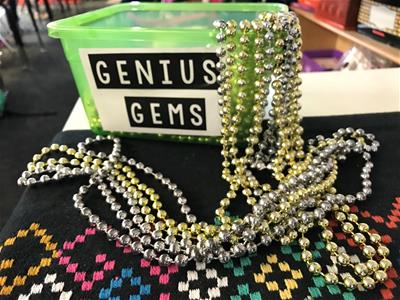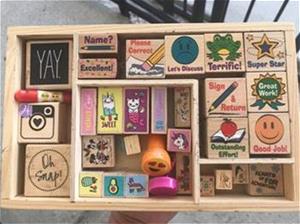
The bell rings and the games begin.
You have one student with untied shoes, one student with field trip money in hand, one student crying in the halls and the rest chatting about their latest escapades on the playground. The struggle is real and as a teacher, you have to find a way to manage it.
Elementary classroom management has many different forms and after a lot of trial and error, I have found the perfect combination of strategies that work for me. Here are four activities for elementary students that even the most frugal teachers can implement easily.
1. Genius Gems

Genius Gems are among my students’ favorite things to earn in class. Every time students are engaged, share a great answer or go above and beyond, they receive a necklace, which they get to wear for the rest of the day. Students love to earn more than one and show them off to their classmates.
To teachers’ benefit, Genius Gems are a one-time “investment.” I buy mine at Dollar Tree or Walmart for about $1 per pack. The bonus? My administrators love to see them on my students, and they view these gems as a unique positive behavioral support system!
2. VIP (Very Important Pupil)


VIP is a designated desk reserved for your Very Important Pupil. On any given day, the selected student gets to sit at this desk and use special supplies while wearing fun shades and relaxing with a big comfy chair and pillows. I even send pictures to the student’s parents so they get a special shout out at home, too.
In addition, the VIP gets to help with various tasks, including taking attendance, doing the lunch count, answering the phone and leading the line. Setting this up costs very little and can be supplied with funky items you may already have on hand.
Students can earn VIP status in my class by:
- Meeting their reading goal
- Completing their online program minutes
- Being kind to other students
- Making growth on assessments
- Achieving goals they set for themselves
3. “Kiss Your Brain” Coupons

“Kiss Your Brain” coupons are my take on a simple classroom economy system. All you need is a roll of tickets!
When students do something awesome, they earn a ticket. They have a pocket to hold their tickets and display their stacks, but you can store them however you would like. Students can use tickets to reap free classroom rewards, from lunch with the teacher to exclusive use of the teacher chair.
The class raffle is a twist on this and my students love it. They can take a chance and add their ticket(s) to the raffle bucket. If I pull their name out of it, they win a prize. (Don’t be afraid to be creative. You’d be surprised how much students love the promotional water bottles you get at healthcare booths or the reusable grocery bags you get from the store!)
Of course, they are not guaranteed a prize with the raffle option, but they learn about taking a risk or playing it safe, teaching them valuable life lessons.
4. Stamp Squad

The Stamp Squad is another recurring incentive in my class. Each day, the students who exhibit positive behaviors receive a stamp on their agenda before they leave to go home. They will do anything to earn these stamps, especially if I tell them I have a new one to share. This incentive is great for the parents too, as it provides instant feedback.
To add an extra element to this management system, offer incentives for students who are on a “stamp streak.” Sometimes I look for a consistent week of stamps, or sometimes two weeks of stamps. The goal post is always changing to keep students on their toes. They may earn free time, first book choice or even an outdoor picnic with the teacher. (Notice how all of the rewards are free.)

Stamps from my collection have lasted years, and I often find stamp sets for $1 at Target and Dollar Tree to keep things fresh. Stamp pads are always great to add to your teacher wish list, too!
What I really like about Stamp Squad is that it also serves as a behavioral running record. You can look back on this during parent-teacher conferences to see behavior patterns, which can be helpful when trying to figure out the most effective behavior plans for a child.
Using Activities to Manage Student Behavior
These classroom management tools have changed my behavior system. There is no need for clip charts, which can make a child feel embarrassed or defeated. There are no points to keep track of on a day-to-day basis, which stops a lot of the “Ms. Machado, you forgot to give me a point” conversations that we teachers love so much.
Instead, students work toward goals at all times. They are learning that hard work pays off. When they are having a rough day–which, let’s face it, we all do–they are not made to feel bad about themselves. Instead, they know they need to try harder tomorrow. Parents love this positive approach to classroom management, and I consistently get praise and feedback from my administrators as well.
If you are looking for new ways to build kids up, get them excited about learning and doing their best, try adding some of these strategies to your tool box. And if you have a particular system that works well for you, please be sure to leave it in the comment box below.
Remember – the greatest resource teachers have is each other!
Develop elementary classroom management skills at American College of Education. Explore our online education degree programs, including our M.Ed. in Elementary Education and M.Ed. in Educational Leadership.

